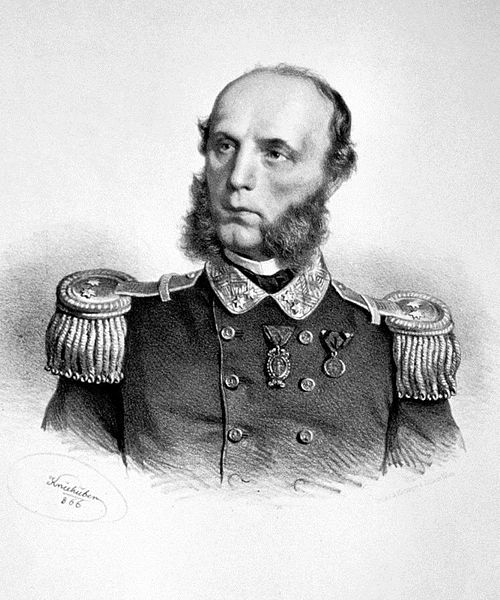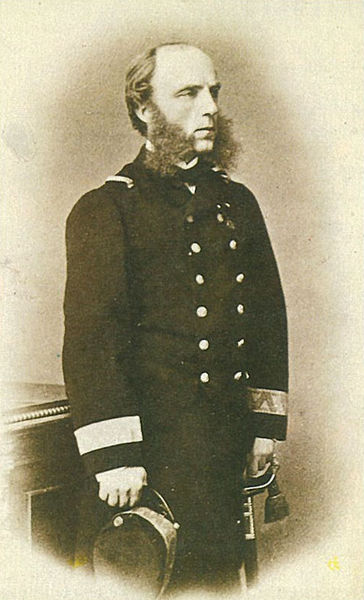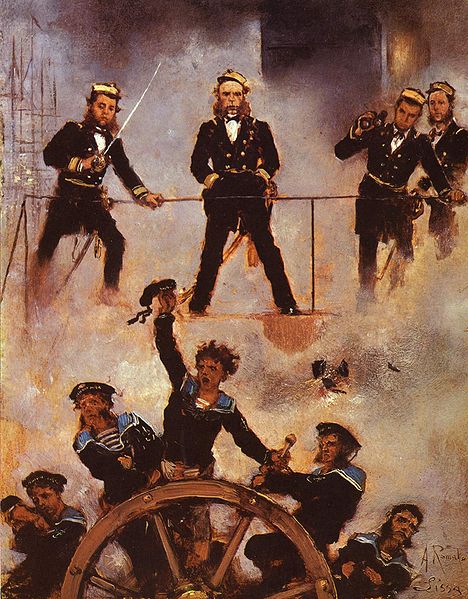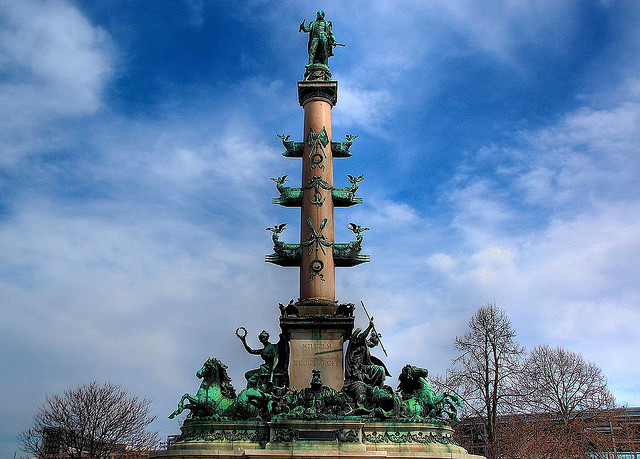<Back to Index>
- Admiral of the Astro - Hungarian Navy Wilhelm von Tegetthoff, 1827
- Composer Joseph Bodin de Boismortier, 1689
- Field Marshal of the Swedish Army Carl Gustaf Wrangel, 1613
PAGE SPONSOR



Wilhelm von Tegetthoff (23 December 1827 – 7 April 1871) was an Austrian admiral. Considered one of the prominent naval commanders of the 19th century, Tegetthoff was known for his innovative tactics as well as his inspirational leadership.
Tegetthoff was born in Marburg, Styria in Austrian Empire (now Maribor in Slovenia), on 23 December 1827 the son of Karl von Tegetthoff, an Oberstleutnant in the Austrian Army. On his mother's side he was related to Johann Kaspar Freiherr von Seiller, Mayor of Vienna from 1851 to 1861. Entering the Marinecollegium (naval academy) in Venice in 1840, Tegetthoff became a Seekadett on 23 July 1845 and witnessed the Venetian uprising in 1848 - 49. He received a commission upon his graduation on 16 April 1849 and took part in the blockade of Venice from May to August 1849. Tegetthoff was promoted to Fregattenleutnant on 16 June 1851 and Linienschiffsleutnant on 16 November 1852.
Tegetthoff received his first command, the naval schooner Elisabeth, in 1854. This was at the time of the Austrian Navy's intensive conversion to steam power, of which he was an earnest advocate. In 1855 he was appointed commander of the paddle steamer Taurus, patrolling the Sulina mouth of the Danube during the Crimean War. This service brought him to the favorable notice of Archduke Ferdinand Maximilian of Austria, the Oberkommandant der Marine (High Commander of the Navy), with whom he had been acquainted since 1850. Promoted to Korvettenkapitän in 1857, Tegtthoff served on a semi - official scientific expedition to the Red Sea. Having shown exceptional diplomatic and organizational ability, in December 1857 he was appointed a staff officer. He was named commander in 1858 of the new screw corvette Erzherzog Friedrich on the coast of Morocco, then in a confused state of disorder.
The
Italian campaign of 1859 saw the Austrians unable to challenge the
French fleet for mastery of the Adriatic. With the return of peace,
Tegetthoff accompanied Ferdinand Maximilian on a voyage to Brazil to visit Emperor Pedro II during the winter of 1859 - 60. Promoted Fregattenkapitän on 27 April 1860 and Linienschiffskapitän on
23 November 1861, he was named commander of the Levant Squadron in
1862. In this capacity, he monitored the Greek revolution that deposed
King Otto I and the anti - Western disturbances in Syria.
During the Second Schleswig War, Tegetthoff as a Kommodor was given command, in February 1864, of a small Austrian squadron that sailed to the North Sea to support the very weak Prussian naval forces against the superior Danish navy which was blockading northern German ports. He was engaged by a Danish squadron commanded by Edouard Suenson at the Battle of Heligoland, in which Tegetthoff's flagship, the screw frigate Schwarzenberg, caught fire in a close range gunnery fight with the Danish frigates Niels Juell and Jylland. Although the action was a tactical defeat for Tegetthoff, he achieved his main objective, since the Danish squadron was shortly thereafter recalled to Copenhagen, lifting the blockade of the Elbe and Weser ports. Tegetthoff's telegraphic dispatch was answered by Emperor Franz Josef I with another on 12 May 1864 promoting him Kontreadmiral (Rear Admiral) and conferring upon him the Order of the Iron Crown.
Tegetthoff was appointed commander of the Austrian battle fleet on 9 May 1866, shortly before the war against Italy. Although the Italian fleet was larger and more powerful, Tegetthoff decided to engage it after a successful reconnaissance of the Italian base of Ancona on 27 June 1866. With their army suffering defeats against the Austrians during the first week of the war from 20 to 27 June 1866, the Italians sought a victory over the Austrian navy by sending their fleet against the Austrian naval base at Lissa, off the coast of Dalmatia near Spàlato (Split) on 16 July 1866. Encountering the Italian fleet early on the morning of 20 July 1866, Tegetthoff sailed straight for the center of the Italian fleet, hoping to ram the ships to make up for his own fleet's lack of firepower (Rammstosstaktik). The smoke from the Italian ships made visibility very poor, however, and the Austrians missed the Italian fleet completely. Swinging around, Tegetthoff again charged, this time setting two Italian armored ships on fire and damaging several more.
After Tegetthoff's flagship, the Erzherzog Ferdinand Max, rammed and sank the armored Italian frigate Re d'Italia, the Italian fleet retreated the next day. Tegetthoff returned in triumph to his base at Pola. Nevertheless, his victory did not materially affect the outcome of the war, as Italy's alliance with Prussia ensured an advantageous peace. Tegetthoff was immediately promoted, by telegraph, to Vizeadmiral (Vice Admiral). He received congratulatory telegrams from Ferdinand Maximilian, by then the embattled Emperor of Mexico, and Vizeadmiral Hans Birch Dahlerup, former Oberkommandant der Marine (High Commandant of the Navy). Tegetthoff was decorated with the Commander's Cross of the Military Order of Maria Theresa and made honorary citizen of Vienna.
Following the victory of Lissa, Tegetthoff urged Franz Josef to annex the hinterland of the Dalmatian coast, so as to protect the region for development of naval bases. This was in fact accomplished with the occupation (1878) and annexation (1908) of Bosnia and Herzegovina, though long after Tegetthoff's death.
Tegetthoff
undertook a journey of study to France, Britain and the United States
in 1866 - 67. Upon the execution of Ferdinand Maximilian by the Mexican government of Benito Juárez, Tegetthoff was sent with the screw frigate Novara to bring his body home to Austria, arriving in the port of Trieste on 16 January 1868.
In March 1868 Tegetthoff took charge as Chef der Marinesektion (Chief of the Naval Section) of the War Ministry of the new dual monarchy. He also received the post of Marinekommandant, as the chief administrative officer of the Navy was now styled. Despite considerable resistance from the General Staff, he vigorously pursued a complete reform of the Austro - Hungarian Navy; his reforms remained in force until the fall of the Donaumonarchie in 1918.
On 1 April 1868 Tegetthoff was made a Geheimrat (Privy Councilor) and a member of the Herrenhaus (House of Lords).
Tegetthoff died suddenly from pneumonia on 7 April 1871 in Vienna at the age of 43. His grave is located in the cemetery of St. Leonhard in Graz. He was succeeded as head of the naval administration by Friedrich von Pöck.
Memorials to Tegetthoff were erected in Marburg (Maribor), Vienna and Pola. The monument on Vienna's Praterstern, the largest traffic junction of the city, consists of a column 11 meters high (by Karl Hasenauer), topped by a bronze statue of Tegetthoff, some 3.5 meters in height, by Karl Kundmann and was finished in 1886. The memorial at Pola, also by Kundmann, was erected in 1877 and consists of a bronze statue of Tegetthoff, with supporting bronze mythological figures. Pola passed to Italian sovereignty in 1919, and in 1935 the monument was moved to Graz, Austria.
Tegetthoff was pictured on an Austrian postage stamp in 1935 and on a 20 euro coin minted in 2004. Ships named for Tegetthoff included:
- The arctic research ship SMS Tegetthoff (1872).
- The armorclad warship SMS Tegetthoff (1878) – renamed SMS Mars in 1912.
- The dreadnought battleship SMS Tegetthoff (1912).
Of these, the first was used in the 1872 – 74 arctic expedition of Julius von Payer and Karl Weyprecht which discovered Franz Josef Land in 1873. The expedition's first discovery was named Cape Tegetthoff.
- Wilhelm von Tegetthoff has left such a legacy behind that he was selected as a motive for a very recent commemorative coin: the 20 euro S.M.S. Erzherzog Ferdinand Max minted on September 15, 2004. The reverse shows the Rear Admiral after a painting by Anton Romako, standing on the bridge of the S.M.S. Erzherzog Ferdinand Max. In front of him four sailors are struggling with the wheel, like bringing the ship into position.
